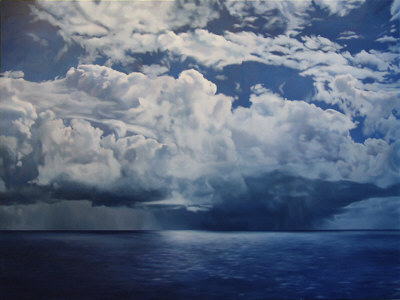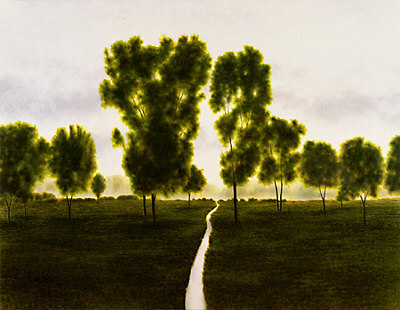April Gornik - Per Contra Interviews

The Wave
2000
Oil on Linen
69" X 77"

Sun, Storm Cloud
2004
Oil on Linen
72” x 96”

Renata's Lake
1987
Oil On Linen
74" x 89"

French Waterway
1997
Oil on linen
72" x 74"
AG: Maybe I didn't talk about it too much early on, but I've thought that Nature represents the Other for me since the early 80s. Nature itself can sometimes feel the way I feel when I choose an image to work with, that is, it feels like something incredibly familiar and meaningful, a kind of déjà vu, and also something that's utterly mysterious and compelling and inscrutable. It draws me as a self-defining possibility.
PC: Does that have anything to do with your being “an American painter”?
AG: I really don't know the answer to this. It seems possible, based on Robert Rosenblum's fine book "Modern Painting and the Northern Romantic Tradition", e.g., since I fit squarely into that notion of abstracted or reinterpreted landscape, but I'm too close to it to have a firm opinion.
PC: I wonder if a time will come again when the question of gender will not be included in an interview of an artist who is a woman. But here it is again. A number of years ago you said, “I get asked increasingly, usually by young female artists, whether I feel there is a different sensibility for women artists than for male artists. I used to say no, no, no, we're all the same, an artist is an artist, don't call me a girl artist. And I've totally changed my feeling about that.” Which reminds me of the cartoon in the New Yorker of two women, sitting at table, engaged in earnest conversation, and one says to the other “And now I would like to be called a girl again.” In the late 90’s a report of your lecture at the University of the Arts, stated, “She said that in the last year or so she has become convinced that there is something in her painting which is essentially female. [...and was looking for a] word that was the female equivalent of ‘phallic.’ She wanted that word to describe ‘the sexual power that I have as a woman that expresses itself in my work.’” The word you were looking for is “yonic.” Could I convince you to talk a bit about how that yonic power expresses itself in your painting?
AG: That specific female power expresses itself in my work in all sorts of ways, but the essence of it for me, I suspect, is the way I use space and my willingness to make penetrable spaces in my work, using symmetry and often deep space, which of course goes against the tendency of modern painting to flat, flatter, flattest. I think about landscape as architectural space that you move into and through. There's also some more obvious yonic imagery, like waterways and waterfalls, that occur. Much of it is subtle, and personal, though. And both men & women can make yonically (?) powerful art. That word has been suggested to me before, but it certainly doesn't carry the cultural freight of a word like phallic. Maybe someday.
PC: In your current artist’s statement, you state succinctly, "I am an artist that values, above all, the ability of art to move me emotionally and psychically. I make art that makes me question, that derives its power from being vulnerable to interpretation, that is intuitive, that is beautiful." In an interview with Constance Lewallen, Kyoto, Japan, 1988, you said “I've always talked about my work in terms of it being fictive and artificial. Artificial has a bad connotation in our society...But my feeling about artifice is that artifice is beautiful and is essential to art.” Is your comment about artifice still, as the phrase once was,” still operational.” Would you please tell us a bit about how the artifice fits in with your concept of beauty as throughout your career you’ve mentioned “beautiful” in connection with, as a subject of your paintings.
AG: Artifice is for me another way of saying fictive, in that the kind of realism I employ is familiar and "natural" but also skewed and contrived. Artifice for me is the manipulation of imagery to give it power, and then the way I paint and construct drawings and paintings uses the power of manipulation in the way fiction reifies life and narrative. It feels real, but it's very interpreted. I "interfere" with reality in a way that hopefully engages the viewer in a more direct and emotional, as opposed to a simply pictorial, way.
PC: You’ve said, “My paintings are places to be alone, to have a place to safely be a witness to chaos, which storms and nature often represent.” And yet the perspective in which you place the audience is mid-air. How does that contribute to his/her having a safe place?
AG: What you imply is right, mid-air isn't typically a safe place to be. It just feels good to me. The way that the mid-air position evolved was initially from painting images from flying, and other, dreams, but it serves a useful purpose in that it kind of throws the viewer into the picture. I guess a feeling of safety depends on how comfortable you'd be in a flying dream or up on a hill looking at something taking place apart from you. Looking at a storm at sea, for instance, can be thrilling. Knowing it might come ashore is part of that thrill. "Safe" is necessarily relative. Because the paintings are meditative I hope that people would be invited to contemplate storms and nature, and experience whatever complexity of feelings might be evoked by those states.
PC: You’re known to be a fan of opera. At least two paintings refer to opera, Renata’s Lake (for Renata Tebaldi) and Brunhildes Wahl. Do you paint listening to opera? Or other music? And are other paintings related to opera, either specific operas, composers or singers?
AG: I haven't been listening to opera that much in recent years because I OD'd on it, but I still enjoy it. The light in Renata's Lake was specifically inspired by listening to Tebaldi's voice. Brunhildes Wahl was titled that because of a possible interpretation of that painting, although I was listening to Wagner a lot around that time. I don't mean either to be illustrational.
PC: The double is a visual theme in your paintings: rocks, fire, islands. You’ve mentioned before how they represent the doppelganager, the possibility of a portal, architecture, existential questions of the self and other. What else would you like to say about the theme—or expand upon for our readers.
AG: I think that about says it all. It's kind of a metaphysical state for me that I haven't gotten to the bottom of, nor do I expect I will. That impulse, to see a pair of things in a landscape, keeps coming back, often unexpectedly. For instance, I didn't realize that the two trees in The Fall, 2001, were also representative of that kind of pairing until a couple of years after I'd painted it. So much of what I know about my work is retrospective it's not funny.
PC: You’ve written about scale and size, calling attention to Gaston Bachelard’s The Poetics of Space, and “‘intimacy in immensity’, by which he’s referring to the way we can make even an immense space be able to be absorbed by our imaginations, and in the case of a poem or a painting, induce a person to have the experience of vastness that feels in proportion to his or her inner expansiveness.” And you’ve commented about size and scale in your own paintings, the “somatic response” the audience has to a painting when standing in front of it. Do you know why the window size paintings are not what you like to make? Could it possibly have something to do with the effect of the window size putting both the artist and audience in an interior looking out, while you’re trying to be outside, returning to your comment about “when you were a kid seeking the outside as a relief...”? (interview with Rush)
AG: I really like that interpretation you made of why the window size doesn't feel comfortable. That size cuts off some ability to become very small or feel comfortably human scale. That said, the drawings are that size, so that belies my supposed rejection of it. But drawing as a medium uses paper as light, and has a natural openness, to me, that paintings don't have. Paintings are much more implosive and powerful and dense, so I'm more comfortable with them either accepting my entire body or being an invitation to miniaturize myself into them. Both those states of being are to me delicious, important, and poetically fraught. Looking at a scene that's neither feels somehow claustrophobic, limited, incomplete. I'm going to use your window interpretation of both viewer and artist being stuck only looking out as my new extended explanation, though, thanks!
For a more complete selection of images, visit April Gornik's Website.